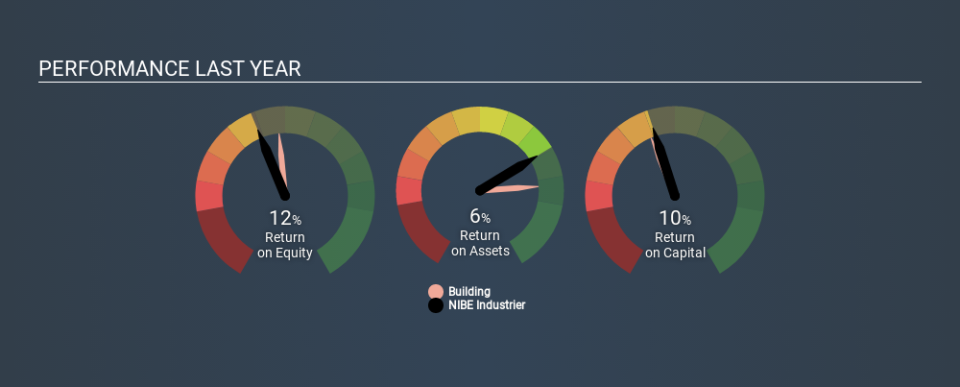NIBE Industrier AB (publ)’s (STO:NIBE B) Investment Returns Are Lagging Its Industry

Today we are going to look at NIBE Industrier AB (publ) (STO:NIBE B) to see whether it might be an attractive investment prospect. Specifically, we'll consider its Return On Capital Employed (ROCE), since that will give us an insight into how efficiently the business can generate profits from the capital it requires.
First of all, we'll work out how to calculate ROCE. Second, we'll look at its ROCE compared to similar companies. Finally, we'll look at how its current liabilities affect its ROCE.
Return On Capital Employed (ROCE): What is it?
ROCE is a measure of a company's yearly pre-tax profit (its return), relative to the capital employed in the business. Generally speaking a higher ROCE is better. Overall, it is a valuable metric that has its flaws. Renowned investment researcher Michael Mauboussin has suggested that a high ROCE can indicate that 'one dollar invested in the company generates value of more than one dollar'.
So, How Do We Calculate ROCE?
Analysts use this formula to calculate return on capital employed:
Return on Capital Employed = Earnings Before Interest and Tax (EBIT) ÷ (Total Assets - Current Liabilities)
Or for NIBE Industrier:
0.099 = kr3.0b ÷ (kr37b - kr7.2b) (Based on the trailing twelve months to December 2019.)
So, NIBE Industrier has an ROCE of 9.9%.
See our latest analysis for NIBE Industrier
Is NIBE Industrier's ROCE Good?
One way to assess ROCE is to compare similar companies. Using our data, NIBE Industrier's ROCE appears to be significantly below the 13% average in the Building industry. This could be seen as a negative, as it suggests some competitors may be employing their capital more efficiently. Independently of how NIBE Industrier compares to its industry, its ROCE in absolute terms appears decent, and the company may be worthy of closer investigation.
You can click on the image below to see (in greater detail) how NIBE Industrier's past growth compares to other companies.
It is important to remember that ROCE shows past performance, and is not necessarily predictive. ROCE can be deceptive for cyclical businesses, as returns can look incredible in boom times, and terribly low in downturns. This is because ROCE only looks at one year, instead of considering returns across a whole cycle. Future performance is what matters, and you can see analyst predictions in our free report on analyst forecasts for the company.
Do NIBE Industrier's Current Liabilities Skew Its ROCE?
Liabilities, such as supplier bills and bank overdrafts, are referred to as current liabilities if they need to be paid within 12 months. Due to the way the ROCE equation works, having large bills due in the near term can make it look as though a company has less capital employed, and thus a higher ROCE than usual. To counteract this, we check if a company has high current liabilities, relative to its total assets.
NIBE Industrier has total assets of kr37b and current liabilities of kr7.2b. Therefore its current liabilities are equivalent to approximately 19% of its total assets. Low current liabilities are not boosting the ROCE too much.
The Bottom Line On NIBE Industrier's ROCE
This is good to see, and with a sound ROCE, NIBE Industrier could be worth a closer look. There might be better investments than NIBE Industrier out there, but you will have to work hard to find them . These promising businesses with rapidly growing earnings might be right up your alley.
There are plenty of other companies that have insiders buying up shares. You probably do not want to miss this free list of growing companies that insiders are buying.
If you spot an error that warrants correction, please contact the editor at editorial-team@simplywallst.com. This article by Simply Wall St is general in nature. It does not constitute a recommendation to buy or sell any stock, and does not take account of your objectives, or your financial situation. Simply Wall St has no position in the stocks mentioned.
We aim to bring you long-term focused research analysis driven by fundamental data. Note that our analysis may not factor in the latest price-sensitive company announcements or qualitative material. Thank you for reading.

 Yahoo Finance
Yahoo Finance 
